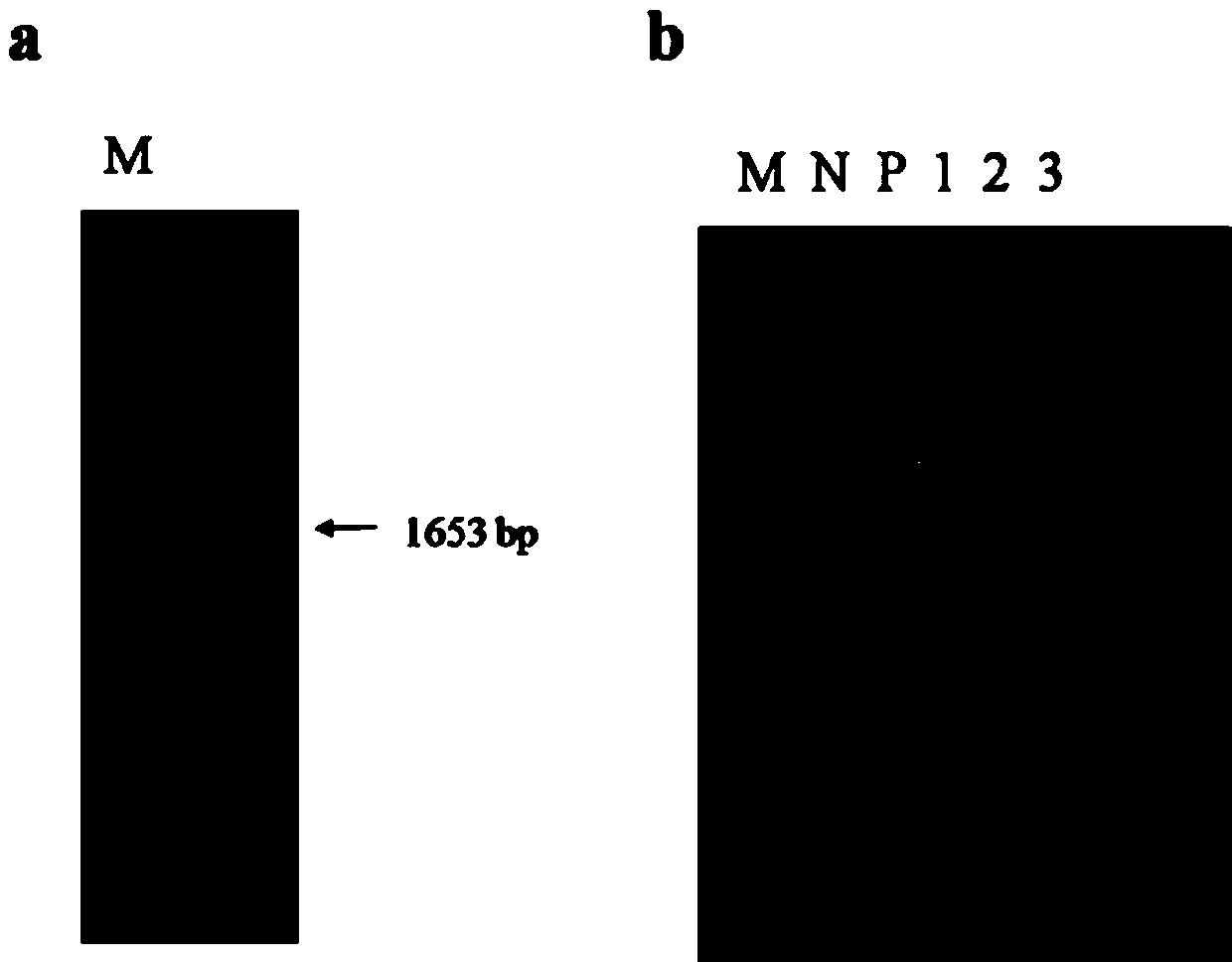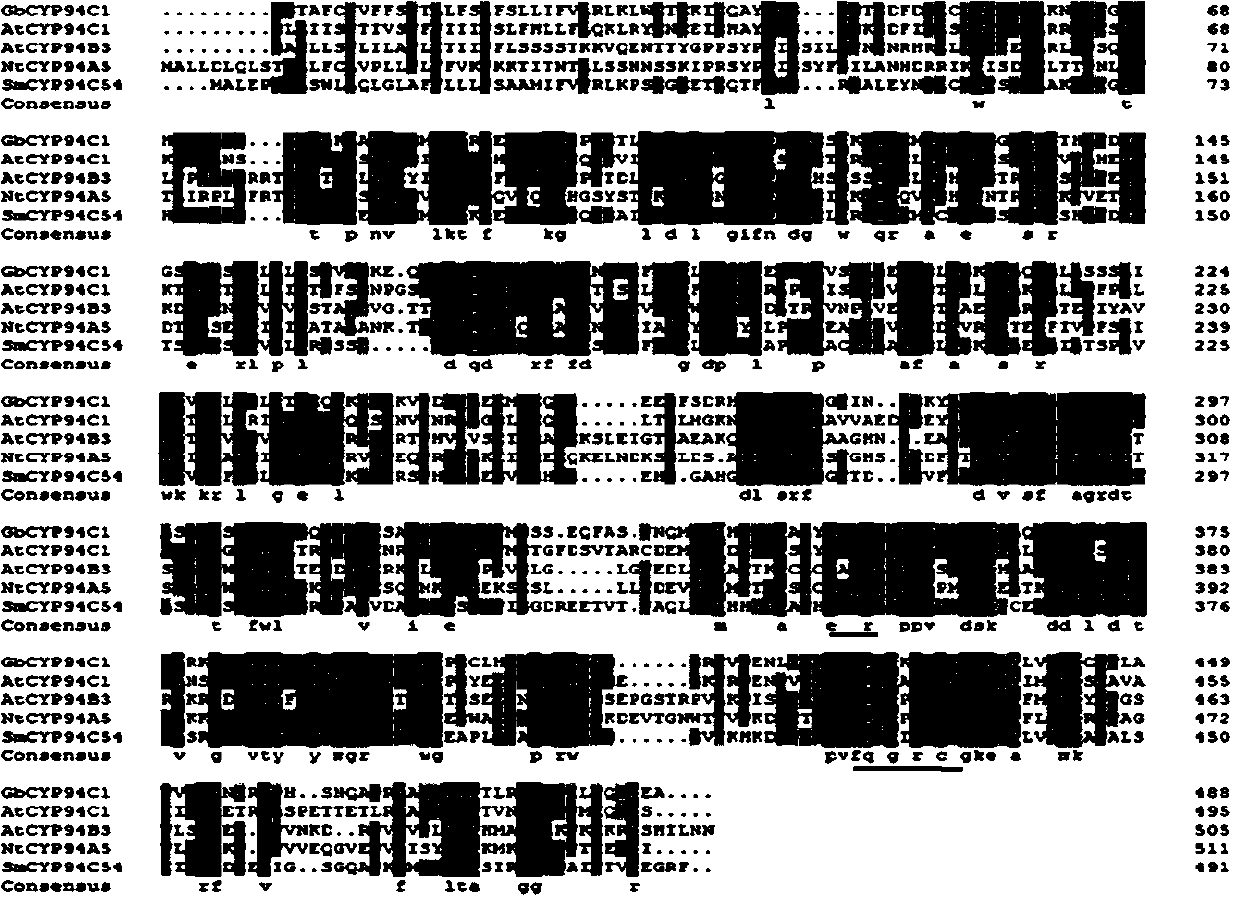Application of Cotton Cytochrome p450 CYP94C1 Gene in Resistance to Verticillium Wilt
A technology of P450CYP94C1, CYP94C1, applied in the field of genetic engineering, can solve complex problems
- Summary
- Abstract
- Description
- Claims
- Application Information
AI Technical Summary
Problems solved by technology
Method used
Image
Examples
Embodiment 1
[0051] Cotton cytochrome P450 CYP94C1 The gene is the basis of the present invention, so the cloning and obtaining process of the gene will be briefly introduced as follows.
[0052] 1. Design primers for PCR amplification
[0053] First, cotton grows for two weeks, and after two cotyledons grow, cotton RNA is extracted, reverse-transcribed into cDNA, and set aside; specifically:
[0054] Referring to the instruction manual, use the EASYspin Plus Plant RNA Rapid Extraction Kit from Aidlab to extract the total RNA of the sample; then perform reverse transcription to obtain cDNA, and the 20 μL reverse transcription system is designed as follows:
[0055] oligo(dT)18, 1 μL;
[0056] RNA, 2 μL;
[0057] RNA free H 2 O, 10 μL;
[0058] 5×buffer, 4 μL;
[0059] dNTPs, 1 μL;
[0060] MLV, 1 μL;
[0061] RNA inhibitor, 1 μL;
[0062] The reverse transcription program is: 65°C, 5 min, 4°C, 1 min, 42°C, 1 h, 85°C, 5 min.
[0063] Then, the primer sequences were designed as fol...
Embodiment 2
[0085] This embodiment mainly introduces that in cotton under the Verticillium dahliae induction and hormone induction mode GbCYP94C1 The changes in gene expression and related experimental procedures are briefly described as follows.
[0086] Cotton under the induction mode of Verticillium dahliae GbCYP94C1 Gene expression changes
[0087] First, germinate cotton seeds, specifically: under the condition of 25°C, soak the cotton seeds in water for 8-12 hours in an incubator, then place them in a petri dish to keep moisture and cultivate them for one day. 25°C, 16 hours of light, 8 hours of darkness); cotton seedlings were inoculated with Verticillium dahliae after three weeks of growth;
[0088] Four days before the cotton seedlings were inoculated with Verticillium dahliae, prepare the Verticillium dahliae infection solution, specifically: Shake the Verticillium dahliae in culture medium (25°C, 150 rpm), filter the bacteria with gauze after four days of cultivation solut...
Embodiment 3
[0114] for further study GbCYP94C1 The relationship between the gene and Verticillium wilt, the inventor used the VIGS technology to analyze the GbCYP94C1 The gene was silenced, and the relevant experimental procedures are described below.
[0115] First, the construction contains GbCYP94C1 gene VIGS vector
[0116] Primers were designed as follows:
[0117] P450-VIGS-F: CCGGAATTCTTAATTGAGACAAGAGCTTG,
[0118] P450-VIGS-R: CGGGGTACCTTTATCAGGAAGAGAAAGAC;
[0119] First the TRV2 empty vector and PCR amplification obtained in embodiment 1 GbCYP94 The C1 gene sequence fragment was double-digested with EcoRI and KpnI enzymes respectively, and the 50 μL restriction enzyme digestion system was designed as follows:
[0120] EcoRI, 2 μL;
[0121] KpnI, 2 μL;
[0122] 10×Buffer, 5 μL;
[0123] TRV2 empty load (or amplified fragment), 41 μL;
[0124] Enzyme digestion at 37°C for 3 h;
[0125] After the double enzyme digestion, perform agarose gel electrophoresis; and use t...
PUM
 Login to View More
Login to View More Abstract
Description
Claims
Application Information
 Login to View More
Login to View More - R&D
- Intellectual Property
- Life Sciences
- Materials
- Tech Scout
- Unparalleled Data Quality
- Higher Quality Content
- 60% Fewer Hallucinations
Browse by: Latest US Patents, China's latest patents, Technical Efficacy Thesaurus, Application Domain, Technology Topic, Popular Technical Reports.
© 2025 PatSnap. All rights reserved.Legal|Privacy policy|Modern Slavery Act Transparency Statement|Sitemap|About US| Contact US: help@patsnap.com



